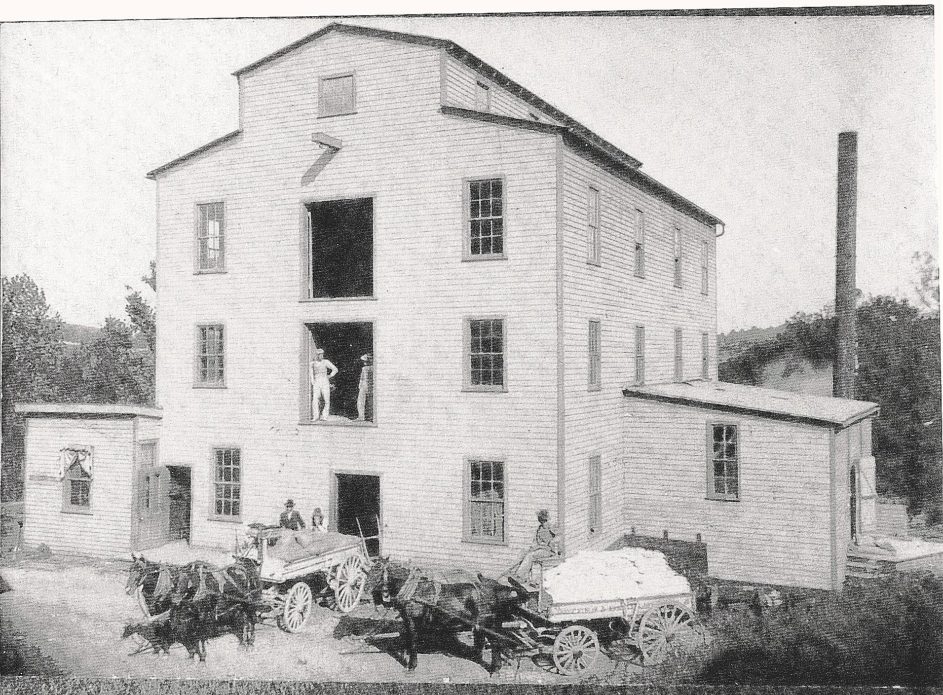Among the industries to thrive in early Knox County were the milling companies, and First Creek and its tributaries was home to several of them. Beginning upstream in Fountain City, there was the Karns’ Mill on Adair’s Creek (bordering present-day Lynnhurst Cemetery), Scott’s Mill (First Creek at Lawson St.) and one of the largest, Peters & Bradley Mill (First Creek at Bluff Ave.).
George W. Peters (1840-1915) served as a captain in the 12th Tennessee Cavalry (USA) for all four years of the Civil War and saw extensive action in Middle Tennessee. He learned the milling business by working at the old Scott Mill on Central St. which was acquired by the Southern Milling Co. and soon closed. In 1867, Peters acquired the old Scott Mill, a rather small mill that was ¼ mile upstream on First Creek from his eventual location.
Peters ran the business alone until 1879 when it was moved to its final location at Bluff Ave., formerly the Goodykuntz Mill. Many of the World War II generation will remember the mill, dam, millpond, flume and the overshot wheel which turned the turbines.
In 1891, the business was incorporated with G.W Peters as president and T.J. Bradley as secretary-treasurer. Bradley remained in the business only until 1894. By 1890, the mill had switched to the roller process and had achieved a capacity of 75 barrels of flour each day, plus the meal and animal feed they also ground. Both water and steam power were used to aggregate 60 horse power and there were 12 employees. Their Snowflake brand flour and P&B Water Ground Corn Meal would be prominent in the local market for many years.
His father hoped that another generation of ownership was assured when William Edgar Peters (1874-1959) was born to George and Jane (Wrinkle) Peters on Aug. 19, 1874. His father encouraged him to pursue a good education which included some courses at the University of Tennessee. When William became 20 years old, he became bookkeeper at the mill and never turned back. He gradually began to take over management and, when his father’s health declined, he and his brother George L. Peters took full charge in 1913.
William Peters married Clara R. Schneider (1874-1942) on June 21, 1898. They became parents to four daughters, including Miss Lillian Peters with whom he lived in the ancestral home at 1319 Granger Ave. after his wife died.
His father had built the first four rooms of the house in the 1860s but undertook a major renovation in the 1880s using an architectural design by the famous local architect, George F. Barber. The addition more than doubled its size and featured Victorian and Neoclassical influences. The large two-story front porch and the columns were highlighted when Knox Heritage featured it one year. Interestingly, there originally was a walkway behind the house that crossed First Creek and connected the home with the mill. The home is now privately owned and on the National Register of Historic Places.

The George W. Peters Home. Built in the 1860s with a major renovation in the 1880s, the home was occupied by George W. Peters and later by his son, William E Peters. It is on the National Register of Historic Places. (Photo supplied)
William Peters served his church and his community in many ways. He served as both a deacon and an elder in Fourth Presbyterian Church and was on the Knoxville Board of Education in 1922-23 and a member of City Council for two terms (1923-1927).
He retired in 1955 after leasing the mill to a concern from Elizabethton. It gradually declined and was finally razed in 1965. William and Lillian continued to live quietly at home until he succumbed to the residual effects of his third surgery at St. Mary’s Hospital on Jan. 12, 1959. After services at Mann’s Mortuary, he was interred in the family burial plot at Greenwood Cemetery. He was survived by his four daughters, seven grandchildren and seven great-grandchildren.
Although it is not widely known, the Peters family left a lasting legacy to their community: they had major acreage in the small community known as Mucktown on the west side of Broadway at Bluff St. Part of the property was sold to Henley Tate and Herman D. “Breezy” Wynn who developed Knox County’s first shopping center, the Million Dollar Broadway Shopping Center, there. And, ironically, Frank Muck, for whom the community was named, was the owner of a livery stable on Central Ave. and sometimes served as a teamster for the Peters & Bradley Mill.
Perhaps their major legacy is the memory the author’s generation has of the iron skillet fried cornbread made with the family staple P&B Cornmeal.

